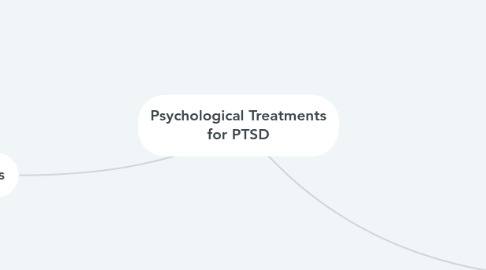
1. Adults
1.1. Psychoeducation
1.1.1. Components
1.1.1.1. Achieve normalization
1.1.1.2. Remove self-blame and self-doubt
1.1.1.3. Correct misunderstanding
1.1.1.4. Enhance clinical credibility
1.1.1.5. Emphasize that treatment works
1.1.2. Important component of all psychotherapeutic approaches
1.1.3. Main goal: understand and reflect
1.2. Group Therapy
1.2.1. Couples/ Family Therapy
1.2.1.1. Family education and facilitated engagement (focus on reduced caregiver distress)
1.2.1.2. Generic or general couple or family therapy (focus on improving relationships with the patient)
1.2.1.3. Partner-assisted therapy (focus on symptom reduction)
1.2.1.4. Disorder-specific family therapies (focus on improving relationships and symptom reduction)
1.2.2. Members with shared experience
1.2.2.1. Psychondynamic/ Interpersonal Focus Group Therapy - Insight and self-understanding - Small to medium positive pre-post changes
1.2.2.2. Cognitive Behavioral Focus Group Therapy - Embodies the concepts of individual CBT; uses homework - Positive results - Research on relative efficacy of group vs. individual treatment
1.2.2.3. Supportive Group Therapy - provides psychoeducation - focus on current life issues - Mixed results
1.3. Alternative Approaches
1.3.1. Hypnosis - equal efficacy with both CBT and Psychodynamic Psychotherapy
1.3.2. Social Rehabilitative Therapies - for severe and chronic PTSD
1.4. Individual Psychotherapy
1.4.1. Technological Delivery of CBT
1.4.1.1. Virtual Reality: - PE treatment provided with the aid of a multimedia delivery system
1.4.1.2. Internet approaches: - overcome avoidance behaviour, access problems, shortage of skilled clinicians - Provide privacy and anonymity - More cost-effective
1.4.1.3. Telehealth Approaches: - Video teleconferencing, telephone-based interventions, web-based interventions, mobile devices - increased accessibility, convenience, individualization
1.4.1.4. Telephones: - Psychotherapy, crisis and suicide hotlines, mobile apps - provides 24h emergency service and good accessibility
1.4.2. Cognitive Behavioral Therapy
1.4.2.1. Prolonged Exposure Therapy: - Imaginal and In-vivo exposure - Separate traumatic memory from the conditioned emotional fear response - 60-70% improvement in all three symptom clusters
1.4.2.2. Cognitive Therapy - identify, challenge and correct dysfunctional automatic thoughts generated by the traumatic event - 60-70% improvement in PTSD symptoms
1.4.2.3. Cognitive Processing Therapy: - includes both cognitive and exposure components (narratives are written by patients) - equally effective as PE
1.4.2.4. Stress Inoculation Training: - aims to reduce avoidance behavior through anxiety reduction and foster a sense of personal competence (social skills training, role playing, distraction techniques) - 60-70% reduction in PTSD-symptom severity
1.4.2.5. Imagery Rehearsal Therapy: - learning of cognitive behavioral techniques for replacing unpleasant nightmare images - often delivered in a group format - 50-60% reduction in nightmare frequency and overall PTSD-symptoms
1.4.2.6. Biofeedback and Relaxation Training: - reduce tension and anxiety with feedback about physiological processes / through breathing and meditation - inefficient on its own --> usually included with other anxiety management techniques
1.4.2.7. Dialectic Behaviour Therapy: - designed for patients with Borderline Personality Disorder and self-destructive behaviour - balanced and flexible approach to reduce chronic impulsive behaviour - no clinical trials
1.4.3. Eye Movement Desensitization and Reprocessing: - belief that saccadic eye-movements or other repetitive motor activities reprogram brain function --> emotional impact of trauma can be resolved - but eye-movements don't seem to be the key therapeutic ingredient
1.4.4. Psychodynamic Psychotherapy: - focus on psychic balance - seeks to understand the context of the traumatic memories and defensive processes (repressed memories)
1.4.4.1. Brief Psychodynamic Psychotherapy: - focus on traumatic event itself, greater sense of self-cohesion, linkage between post-traumatic distress and current life stress - 40% improvement of intrusion and avoidance symptoms
1.4.4.2. Brief Eclectic Psychotherapy: - combines elements CBT and psychodynamic psychotherapy
1.4.4.3. Present-Centered Therapies: - focus on here-and-now problems caused by the PTSD-symptoms - problem-solving therapy, emotional support, anxiety management techniques
1.4.4.4. Third-wave/ Mindfulness Approaches: - influenced by Zen-Buddhism - acceptance of self and internal experiences
1.4.4.5. Supportive Therapies: - unstructured and variable approach - provide emotional support to cope with daily life situations
2. Children and Adults
2.1. - Often age-appropriate interventions from adult treatment methods - Importance of the developmental stage at which the trauma occurred
2.2. CBT for Children and Adolescents
2.2.1. Common components (acronym PRACTICE): Psychoeducation, Relaxation and stress management skills, Affective expression and modulation skills, Cognitive coping skills, Trauma narrative and cognitive processing, In vivo desensitization, Conjoint child-parent sessions, Enhancing safety and future development
2.3. Other Promising CBT Approaches
2.3.1. Cognitive-based CBT: - for children exposed to single incident trauma
2.3.2. Seeking Safety
2.4. Group School-Based Treatments: - focus on community violence, accidents, disasters, traumatic grief - school-wide curricular interventions, interventions for at-risk students, school-based treatments - most widely used: cognitive behaviour intervention for trauma in schools (CBITS)
2.5. Psychodynamic Therapy
2.5.1. Child-parent psychotherapy: - strengthens child-parent relationship
2.5.2. Attachment and biobehavioral catch-up: - for young maltreated children in foster care to improve the child-caregiver relationship and reduce affect dysregulation

